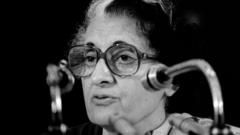What Happened During Indira Gandhi's Emergency That Stopped India's Democracy?

Understanding the Emergency in India: A Deep Dive into a Defining Moment
The Emergency declared in India on June 25, 1975, stands as one of the most controversial and defining moments in the country’s history. It marked a time when the world's largest democracy experienced unprecedented authoritarian measures, leading to the suspension of civil liberties and the suppression of dissent. This article delves into the events leading to the Emergency, its implementation, and the long-lasting impacts on Indian democracy.
The Prelude to the Emergency
The roots of the Emergency can be traced back to the political turmoil in India during the early 1970s. Prime Minister Indira Gandhi, who was in power since 1966, faced mounting challenges. The tipping point came with a landmark decision from the Allahabad High Court, which found her guilty of electoral malpractice related to her 1971 election campaign. This verdict not only invalidated her election but also threatened her political career.
In an atmosphere charged with public protests led by prominent figures like Jayaprakash Narayan, Gandhi made a fateful decision. Citing threats to national stability and the integrity of the state, she declared a nationwide Emergency under Article 352 of the Indian Constitution. This declaration allowed the government to assume extraordinary powers, effectively sidelining democratic processes.
The Mechanisms of Control
Once the Emergency was declared, India transformed dramatically. Civil liberties were suspended, opposition leaders were jailed, and the media faced stringent censorship. Over 110,000 people were arrested, including key opposition figures such as Morarji Desai, Jyoti Basu, and LK Advani. The political landscape was altered overnight as dissent was crushed under the weight of state power.
Judicial Independence Undermined
The judiciary, the guardian of civil liberties, found itself stripped of its independence. Courts became ineffective in protecting the fundamental rights of citizens. In Uttar Pradesh, the state that recorded the highest number of detentions, not a single order of detention was overturned. The judicial system was rendered powerless as citizens were denied the right to challenge their detentions, leading to widespread human rights violations.
Forced Sterilizations: A Dark Chapter
One of the most controversial aspects of the Emergency was the aggressive family planning campaign led by the government, which aimed to control population growth. An estimated 11 million people were sterilized, with many cases involving coercion. The infamous "Castration Colony" in Delhi became a symbol of this brutal campaign, where men were forced into sterilization procedures, often under the threat of losing their jobs or livelihoods.
The government’s push for sterilization was not merely a public health initiative; it reflected a campaign of social engineering that disproportionately affected the poor. Many families found themselves financially devastated as cash incentives for undergoing surgery equaled a month’s income or more. In some instances, entire communities were targeted to meet state-imposed quotas, leading to violent incidents and community unrest.
Slum Demolitions and Social Cleansing
Alongside forced sterilizations, the Emergency saw a ruthless urban "clean-up" campaign. Approximately 120,000 slums were demolished, displacing around 700,000 people in Delhi alone. Critics labeled this campaign as social cleansing, as the displaced were often relocated far from their workplaces into inadequate resettlement colonies.
One of the most tragic incidents occurred in the Turkman Gate neighborhood, where police fired on protesters resisting the demolitions. This brutal crackdown resulted in the deaths of at least six individuals and thousands more being displaced. The violence and suffering of those affected highlighted the callousness of the government's approach to urban planning during this period.
The Silent Press: Censorship and Media Control
With the declaration of the Emergency, the press faced immediate and draconian censorship. On the eve of the Emergency, power to newspaper presses in Delhi was abruptly cut, silencing dissenting voices. Major publications like The Indian Express and The Statesman resorted to printing blank columns to protest against censorship, signaling the extent of media suppression.
Censorship extended beyond mere reporting; it dictated what could be published and what topics were off-limits. Journalists faced severe repercussions for any form of dissent, including expulsion from the country. Foreign journalists like BBC's Mark Tully were forced to leave India for refusing to comply with the government's censorship agreements.
Censorship and the Public's Right to Know
As documented by journalist Coomi Kapoor, the censorship regime was comprehensive. Reporting on slum demolitions, conditions in prisons, and developments in opposition-ruled states was strictly prohibited. The government sought to control narratives, even extending to trivial topics, effectively suffocating any dissenting opinion.
Resistance and the Response from Civil Society
While the government managed to suppress significant opposition, pockets of resistance did emerge. Some judges in the Bombay and Gujarat high courts warned against the misuse of censorship, arguing that it could not be employed to manipulate public perception. However, such voices were drowned out by the overwhelming power of the state.
Despite the dire circumstances, the Emergency also inadvertently led to a shift in political dynamics. The Youth Congress, under Sanjay Gandhi, pushed a five-point agenda that included family planning and adult literacy. This merging of personal and state policies illustrated the blurring of lines between governance and individual ambition during this period.
The Economic Landscape
Interestingly, the Emergency is often viewed through the dual lenses of repression and economic recovery. Although the regime enforced harsh measures, it also facilitated a rebound in the economy after years of stagnation. Production levels rose, trains ran on time, and crime rates fell, leading some to perceive the Emergency as a time of stability.
Business leaders like JRD Tata praised the government's approach, describing it as pragmatic. However, such views often overlooked the underlying human rights violations and the erosion of democratic institutions that occurred during this period.
The Aftermath: Repercussions and Lessons Learned
The Emergency officially ended in March 1977 when Indira Gandhi called for new elections, only to lose to the opposition coalition, the Janata Party. The new government sought to roll back many of the laws enacted during the Emergency, but the damage had already been done. The episode revealed how fragile democratic institutions could be when power went unchecked.
Reflections on Democracy
Historians and political analysts have since reflected on the implications of the Emergency for Indian democracy. The period is often remembered as an aberration, a momentary lapse into authoritarianism. However, such a framing may lead to complacency regarding present-day democratic practices. As historian Gyan Prakash suggests, the Emergency should serve as a cautionary tale about the fragility of democratic systems and the dangers of hero worship.
BR Ambedkar, the architect of the Indian Constitution, had warned against the surrender of freedoms to charismatic leaders. The lessons from the Emergency continue to resonate today, reminding us that democracy requires constant vigilance and active participation from its citizens.
Conclusion: The Imperative of Vigilance
The Emergency in India was not merely a historical event but a pivotal moment that reshaped the political landscape of the nation. It serves as a reminder of the importance of safeguarding democratic institutions and civil liberties. As we reflect on this period, it is crucial to remain vigilant against the erosion of democratic values and to foster a culture of accountability in governance.
Understanding the past is essential for building a more resilient future. The Emergency, with all its complexities, teaches us that democracy is not just a system of governance but a continuous struggle for justice, equality, and freedom.
Frequently Asked Questions
What triggered the Emergency in India?
The Emergency was triggered by a verdict from the Allahabad High Court that found Prime Minister Indira Gandhi guilty of electoral malpractice, leading to widespread protests and her decision to declare an Emergency under Article 352 of the Constitution.
How long did the Emergency last in India?
The Emergency lasted for 21 months, from June 25, 1975, to March 21, 1977, when Indira Gandhi called for elections and subsequently lost her position to the opposition coalition.
What were the major consequences of the Emergency?
The Emergency led to the suspension of civil liberties, widespread arrests, forced sterilizations, and severe media censorship. It also highlighted the fragility of democratic institutions in India.
How did the Emergency affect the economy in India?
Despite its repressive measures, the Emergency facilitated economic recovery, with increased production levels and improved public order, but at the cost of civil rights and democratic governance.
What lessons can be learned from the Emergency in India?
The Emergency serves as a reminder of the importance of protecting democratic institutions and civil liberties. It highlights the need for vigilance and active citizen participation in governance to prevent authoritarianism.
As we reflect on this significant chapter in India’s history, it prompts us to consider: how can we ensure that the lessons of the Emergency are not forgotten in our pursuit of a just and equitable society? #EmergencyInIndia #Democracy #CivilLiberties
Published: 2025-06-26 05:12:28 | Category: world



